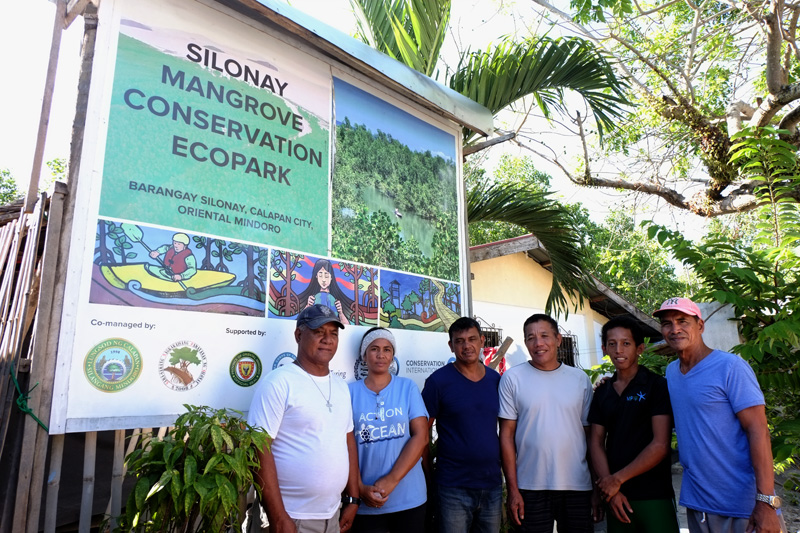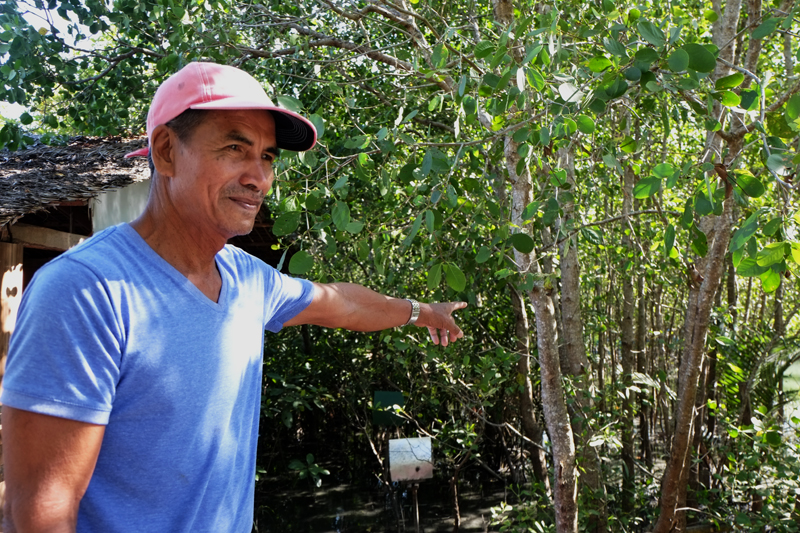How a mangrove forest in Calapan City is giving back to its community

CALAPAN CITY, Philippines — In 2013, locals of Brgy. Silonay in Calapan City, Oriental Mindoro saw how Super Typhoon Yolanda devasted Tacloban City in Leyte. Unlike Tacloban, their community was spared from one of from the strongest typhoons that ever made landfall in the Philippines. They didn’t need to evacuate despite living along the coastline too.
Silonay had its own protective barrier, a mangrove forest.
Called the Silonay Mangrove Conservation and Eco-tourism Park, it is managed and ran by Sama-samang Nagkakaisang Pamayanan ng Silonay (SNPS). This people’s organization is led by barangay officials and community volunteers who dedicate their effort and time to their mangroves, which give them so much in return.
A green intervention
In an exclusive interview with Philstar.com, Silonay Brgy. Captain Francisco Fortu alongside SNPS officials Benecio Vergara, Ricardo Ponsones and Moral Bool recalled how the mangrove forest used to be a river that flowed out to Verde Island Passage. During storms, it caused flooding and pushed residents farther and farther away from their original settlement by the river.
In 1991, the destructive Mt. Pinatubo earthquake took place in Luzon but from this incident, mangrove seedlings began sprouting everywhere in the river. The barangay and SNPS officials believed that these seedlings came from the few mangrove trees that grew where the river met the sea.
Soon, more and more mangroves occupied their river but the locals saw other use for the trees. “In the beginning, locals here didn’t understand the importance of the mangroves,” Ponsones said. “We used to cut and gather the trees for firewood.”
Intervention came in 2009 when Conservation International (CI) Philippines, a non-profit environmental organization, identified Brgy. Silonay as one of the most vulnerable places to climate change in Verde Island Passage.

From only 26 members in 2012, the Sama-samang Nagkakaisang Pamayanan ng Silonay has now grown to almost 80 members. Photo shows (from left) Chairman of the Board Benecio Vergara, full-time volunteer Alam Bool, honeybee farm manager Moral Bool. Silonay Barangay Captain Francisco Fortu, eco-tours manager Alowin Simblante, and mangrove seedling nursery manager Ricardo Ponsones. Philstar.com/Euden Valdez
“The coastal village, or barangay, of Silonay in Calapan City, Oriental Mindoro has been constantly threatened by storm surges due to its geographic location,” wrote Enrique Nunez for CI Philippines.
Other climate change-related threats include rise in sea levels, decrease in fish population due to coral bleaching, and more frequent and stronger typhoons.
CI Philippines told its finding to community leaders and explained to them that if they protected their mangroves, it would protect them in return.
With the support of the local governments of Calapan City and Oriental Mindoro, CI Philippines granted Brgy. Silonay a mangrove rehabilitation and income diversification project. In return, the community committed to plant 100,000 mangrove trees every year.
This officially established the 42-hectare Silonay Mangrove Conservation and Eco-tourism Park, through an amended City Fisheries Ordinance.
Taking responsibility
According to Ponsones, it was difficult to convince his fellow Silonay residents to stop cutting the mangroves and instead plant more of it. Yolanda in 2013 opened their eyes to the importance of mangroves. The trees could actually save their lives.
“Ngayon, wala nang nagpuputol ng bakawan. Kapag may nakikita silang taga-ibang barangay na namumutol ng mangrove namin, nire-report nila kaagad sa amin,” Ponsones said.

According to Ricardo Ponsones, a barangay and SNPS official, it was difficult to convince his fellow Silonay residents to stop cutting the mangroves and instead plant more of it. Super Typhoon Yolanda in 2013 opened their eyes to the importance of mangroves. Philstar.com/Euden Valdez
SNPS now has grown to almost 80 members, from the original 26 members in 2012, who were mostly barangay officials and employees.
The SNPS volunteers regularly receive training from CI Philippines, to make sure the sustainability of their conservation efforts.
“Ang aming partner na NGO na Conservation International Philippines ang nagbibigay ng trainings sa amin, especially about sa scientific way of planting and protecting mangroves. Dapat kasi itatanim sila sa mga tamang lugar para sila mabuhay at hindi masayang,” said Alma Bool, a full-time volunteer of SNPS.
The fisheries offices of their city and provincial governments also lend a hand in training, she added.
Bool is the most knowledgeable when it comes to the mangrove species. She knows all 15 of them, including their local names and scientific names.
“Meron po kaming mga true mangrove species tulad nang Sonneratia alba o pagatpat. Meron ding pong Rhizophora species, Rhizophora mucronata at Rhizophora apiculata. Dito po sa atin, ang mucronata po ang tinatawag na bakaw babae at ang apiculata naman po ang bakaw lalake. Meron din pong Avicenniaceae species tulad Avicennia rumphiana at officinalis, o ang tinatawag po nating bungalon at api-api,” she named just a few.
Species of fauna have also been recorded in the Silonay mangrove park including 29 birds, seven of which are endemic like the Philippine Duck and Pygmy Swiftlet, among others. There are also two species of bats, and five species of amphibians and reptiles have been spotted—indicators that the mangrove forest has become an ecosystem for both flora and fauna.
Reaping the benefits
Beyond protection from climate change, Silonay’s mangroves have also been providing a livelihood to the community through eco-tourism.
The mangrove park is one of the promoted eco-tourism destinations by the Oriental Mindoro Tourism Office. The local tourism office brought media representatives and travel bloggers from Manila to see Silonay’s natural wonder.
The P50-entrance fee comes with one seedling, which a visitor can personally plant. Tourists can get up close and personal to the ever-expanding mangrove park by walking along a 900-meter boardwalk. At the end of this is a watchtower.
However, a typhoon last year damaged the original boardwalk so it is being reconstructed this year. The remaining half that is connected to the watchtower is still under repair.

Visitos of the 42-hectare Silonay Mangrove Conservation and Eco-tourism Park can get up close and personal to the ever-expanding mangrove park by walking along a 900-meter boardwalk. At the end of this is a watchtower. Philstar.com/Euden Valdez
The boardwalk, along with kayaks, was originally donated by CI Philippines to help SNPS volunteers monitor the area and keep a lookout for rule-breakers. Later on, these were also utilized as attractions for tourists.
The earnings from tourist fees are also used by SNPS volunteers for other income-generating projects like selling souvenir T-shirts and snacks from the small shop they were able to open at the park entrance.
Another long-term benefit that Silonay residents now reap is improvement in fishing since mangroves serve as laying grounds for fish, as well as nurseries for the small fish. In coastal communities, fishing is the main source of livelihood.
“Before there were mangroves here, fishing was quite difficult, and it got to a point that our catch was so limited that we had to venture farther,” Councilor Bool said in a CI Philippines article.
All these ensure the sustainability of Silonay Mangrove Conservation and Eco-tourism Park.
“Para sa akin, ang pagiging volunteer para sa mga mangroves ay pagtulong sa aming komunidad. Napakadaming benepisyo ang binibigay ng bakawan sa amin,” Alma Bool concluded.



















